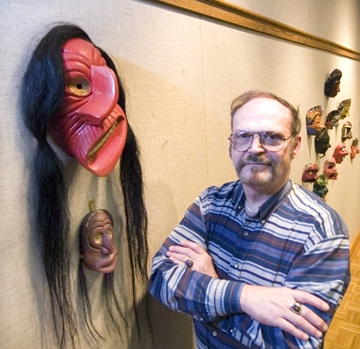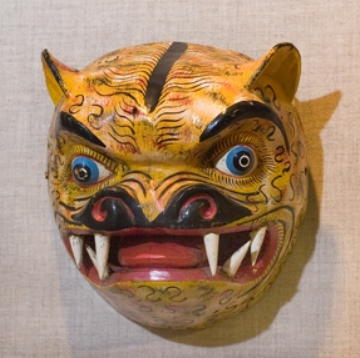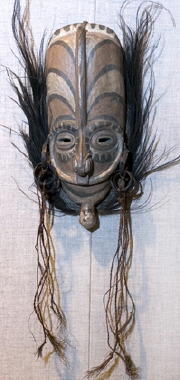WORLD MASK EXHIBIT HELD OVER THROUGH SATURDAY AT GSC

Rick Tubesing stands beside an Iroquois Curing Society mask
from up-state New York - used in a ceremony to cure incurable
diseases. A child's mask is hung below the red adult mask.
(Photos by Drew Moody)
By Drew Moody
Entitled "Transmutation," the mask collection of Rick Tubesing is both a journey through time and cultural traditions. Some are simply done as sculpture, others are part of a costume, and a few are examples of ceremonial masks.
The roughly 150 masks displayed in the Fine Arts Center gallery are from across the globe. While the majority are from North and South America, the collection also features a variety of masks from Africa, Japan, Indonesia and Tibet.
Duane Chapman, fine arts chairman, brought the exhibit to Glenville State College to coincide with multi-cultural fair activities which brought hundreds of middle school students to the college for a variety of day long presentations. Students from Elkins, Tygarts Valley and Braxton County attended the events.
Tubesing, retired as Glenville State College's library director eight years ago. However, prior to his journey bringing him to Gilmer County, he was somewhat of a globe-trotter, traveling and teaching at several prominent universities.
He's a veteran of the U.S. Navy, earned an undergraduate degree in English Literature from Yale, and successfully completed a master's degree in anthropology - before later getting a second master's in librarianship.
While still in his early years in college he acquired his first mask - an Iroquois Curing Society Mask from up-state New York. It was carved by a Curing Society member, but never used in a ritual.
These masks were used in a healing ceremony to cure "incurable diseases." Once used in such a ceremony the masks were considered sacred.
If the society held a ceremony and that individual was cured the person had the option of joining the society, because then they'd be a true believer.
By being cured, that person "had gained the favor of 'the old ones' and (they) had the potential of being the vehicle for someone else being cured," Tubesing said. The 'old ones' were one of four Curing Society Gods who were protectors of the Iroquois.
Once cured they could either carve, or hire a professional carver to create a mask for them. The masks were carved on a living basswood tree, after first getting the tree's permission. The final act was detaching the mask from the tree.
For the individual who was 'cured' the mask was considered sacred. It was placed in the home as a protector of the family. It was intimately connected to that individual through life and on into the grave at death.

Jaguar Mask - Used each Spring as a learning ritual to teach
young boys to drive the big cats back into the jungle. They
were taught to respect, not hurt, the jaguar. The ritual
showed them how to keep the villagers territory safely separate.
ANCIENT HISTORY OF MASKS
Tubesing has traveled extensively throughout Mexico and into the high mountains of Guatemala searching for masks.
Some were purchased in antique stores, others were obtained in very rural areas from the artist, and a few were found on e-Bay.
The use of masks are documented back to 40,000 B.C., Tubesing said. Throughout history they've had a variety of purposes ranging simple costuming for parades to sacred rituals. Most are nothing more than consumable parts to costumes.
"I collected it from an anthropological perspective," Tubesing said. He has focused his efforts of study on how the masks functioned in the various cultures. His interest has been in accurately representing different types of masks, and has managed to assemble the collection without investing much money in the items.
The scope of the collection includes items that were created simply as works of art, to representations of a continuing traditions, such as the Japanese masks. While others, such as the Seven Deadly Sin collection, represents a relatively new style from Mexico.
"This is a museum quality show," Chapman added. "It's better than an 'Indiana Jones' movie." ('Indiana Jones' is a fictional professor, archaeologist, adventurer and main character of the 1981 movie "Raiders of the Lost Ark," starring Harrison Ford. Two other movies based on the character were released in 1984 and 1989. A fourth 'Indiana Jones' movie, also starring Ford, is scheduled to be released in May 2008.)
"You can take a trip around the world and get insight into a culture," Chapman continued. Represented in the collection is an array of different cultures, different beliefs and different societies.
"Very interesting decor items," commented one individual.
"It's cool, but it needs more color," wrote another.
As an artist Chapman sees the masks both artistically and culturally. He's been using the exhibit in his survey of art classes.
Tubesing enjoys talking with grade-school children the most. "The youngsters are open to evaluating the collection without preconceptions courtesy of popular culture."
 Voice of the Ancestors - Masks
like these were used speak in
the voice of the ancestors during
meeting and ceremonies. When
speaking as the ancestors the
individual would hold the mask in
front of their face. When speaking
as themselves, they took it down.
Voice of the Ancestors - Masks
like these were used speak in
the voice of the ancestors during
meeting and ceremonies. When
speaking as the ancestors the
individual would hold the mask in
front of their face. When speaking
as themselves, they took it down.
"They are more receptive to the idea somebody puts on one of these masks and speaks in the voice of the grandfathers." He compared it to children being able to imagine Santa Claus speaking.
As a natural consequence of aging, Tubesing said, it becomes more difficult to see other perspectives. He clarified the point by adding it was perfectly legitimate for someone to say "I'm not interested in that," comparing it to his dislike for opera.
However, in practice, adults tend to be restricted in their willingness to understand that which isn't familiar.
"They can verbally say I understand this," he continued, "but for them to see the reality of another culture, for another person, becomes increasingly difficult for adults."
A variety of events are being held on campus this weekend, including an alumni reunion which kicks off with a reception at the Alumni Center Friday at 6 p.m.
At 7 p.m. Friday the Glenville State College Concert Band will present its annual Spring Concert. Glenville State College professor Donna Maher will be featured as solo flutist.
The bluegrass band Mountain Fury will take the stage at the Fine Arts Center auditorium Saturday at 3 p.m. for a concert. A pre-banquet reception begins at 5:15 p.m. immediately outside the ballroom of the Alan B. Mollohan Campus Center. Mountain Fury will play again during the Alumni Banquet, scheduled to begin at 6 p.m. in the ballroom.
The mask exhibit will be open Friday from 10 a.m. - 2 p.m, and again Friday evening from 6-7 p.m. prior to the concert band performance. The mask exhibit will conclude Saturday when the gallery will be open from noon - 5 p.m.